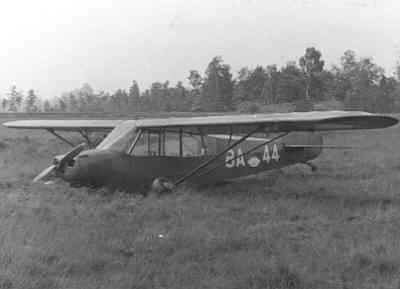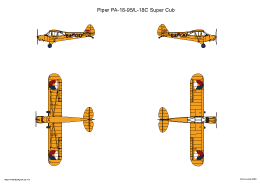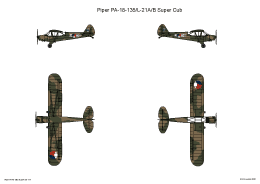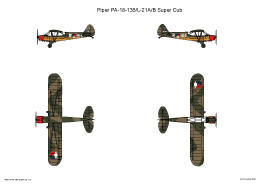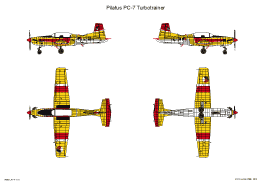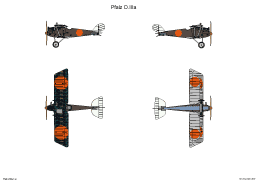- Details
- Hits: 12019
History
The Piper L4 Cub basically originates from the Taylor E3 Taylor, which was built by Taylor Aircraft in 1930. W.T. Piper was the main investor in the Taylor factory and became the owner after the bankruptcy of Taylor Aircraft.
In 1936 the design was significantly modified by W. Jamouneau, creating a new type, which was designated as Piper J-2. Between 1936 and 1938 1200 examples were produced.
In 1938, the factory was burned to the ground entirely and a new one was built in Lock Haven. There Taylor Aircraft started building the J-3, an improved version of the J-2.
The J-3 could be fitted with different engines, the J=3C for example had a Continental A engine.
With the outbreak of the Second World War in 1939, a initially civilian training program was set up in the USA, where the Piper J-3 was used. Between 1939 and 1940, then were more than 3000 Piper J-3s built.
In 1941 a military version was released, called Piper O-59, in 1942 changed to L-4 and NE (US Navy designation). This hardly differed from the original civilian J-3.
The L-4 Grasshopper had a canopy with more glass panes in order to improve visibility.
Over 5400 examples were built, including 250 NE-1 and NE-2 for the US Navy.
All L-4 versions had a tandem cockpit and were, like the Taylor Craft L2 and Aeronca L-3 referred to as Grasshopper.
During the war the L-4 was used for a variety of tasks such as reconnaissance, light transport, artillery reconnaissance and also for medical transport (medevac)
After the war, many aircraft were sold as surplus, but many were still used in military service.
Versions.
- J-3:
- original version with a Continental A-40, A-40-2 or A-40-3 engine rated 28 kW.
- J3C-40 :
- Version built from July 1938 with a Continental A-40-4 or A-40-5 rated 30 kW.
- J3C-50 :
- Version built from July 1938 with a Continental A-50-1 or A-40-2 up to A-40 -9 rated 37 kW.
- J3C-50S with an optional float kit.
- J3C-65 :
- Version built from July 1939 with a Continental A-65-1, A-65-3, 6, 7, 8, 8F, 9 or 14 rated 48 kW or a Continental A-65-14, A-75-8, A-75-8-9 or A-75-12 rated 56 kW or a Continental A-85-8 or C-85-12 rated 63 kW or a Continental A-90-8F rated 67 kW.
- J3C-65S: with an optional float kit.
- YO-59: Four examples of the J3C-65 for test and evaluation purposes for US Army.
- O-59:: Production version for USAAC; later designated as L-4
- O-59A: improved USAAC version with a Continental O-170-3 rated 48 kW; later designated as L-4A.
- L-4B: as L-4A, but without radio.
- L-4H: as L-4B, but with improved equipment and fixed pitch propeller.
- L-4J: as L-4H with variable pitch propeller.
- NE-1: US Navy designation of the J3C-65 with double steering; 230 examples built.
- NE-2: NE-1 with minor changes of equipment, 20 examples built.
- J3F-50 :
- Version built from July 1938 with a Franklin 4AC-150 Series 50 rated 37 kW.
- J3F-50S: with an optional float kit.
- J3F-60 :
- Version built from April 1940 with a Franklin 4AC-150 Series A engine rated 48 kW or a Franklin 4AC-171 rated 45 kW.
- J3F-60S: with an optional float kit
- J3F-65 :
- Version built from Augustus 1940 with a Franklin 4AC-176-B2 or a Franklin 4AC-176-BA2 rated 48 kW.
- De J3F-65S: with an optional float kit.
- L-4D: designation of five examples of the J3F-65 for the USAAC
- J3L :
- built form September 1938 and equipped with a Lycoming O-145-A1 engine rated 37 kW or a Lycoming O-145-A2 or A3 engine rated 41 kW.
- J3L-S: with an optional float kit.
- J3L-65 :
- built from May 1940 equipped with a Lycoming O-145-B1, B2 or B3 rated 48 kW.
- J3L-65S: with an optional float kit.
- L-4C: designation of eight examples of the J3L-65, initially referred to as UC-83A.
- J3P :
- Version with a Lenape LM-3-50 or Lenape AR-3-160 rated 37 kW.
- J-3R :
- Version with slotted flaps and a Lenape LM-3-65 rated 48 kW.
- J-3X :
- version built in 1944 with a cantilever wing and a Continental A-65-8 rated 48 kW
- Commandre :
- French version of the J-3 Cub
- TG-8 :
- Three seat glider version for training purposes, 250 examples built.
- LNP: US Navy designation of three TG-8s.
| Dimensions: | |||
| Length: | 6,83 m | Wingspan: | 10,74 m |
| Height: | 2,03 m | Wing area: | - m2 |
| Weights: | |||
| Empty weight: | 345 kg | Max. start weight: | 550 kg |
| Performances: | |||
| Max. speed: | 140 km/hr | Climbing speed: | - m/min |
| Cruising speed: | 121 km/hr | ||
| Range: | 354 km | Service ceiling: | 3500 m |
| Miscellaneous: | |||
| Engine type: | One Continental O-170-3 rated 65 hp | ||
| Crew: | - | ||
| Armament: | None | ||
After the Second World War, the former Dutch East Indies were (temporarily) governed by the British government.
Just in December 1945 put the first Dutch troops entered officially Dutch-Indian soil.
In the course of the year was a need for a liaison and also to support the KNIL (NEi Army) and 17 squadron was established.
At that time, four ex Japanese biplanes, obtained from the RAF, were used for reconnaissance purposes.
The first three Piper Cubs were purchased in September 1945 by F/O Captain Schoof for use as a sports aircraft for freed KNIL soldiers who stayed in a camp in Manila in the Philippines. The new aircraft were declared surplus and were obtained from a dump. The devices kept their American serials.
In early November 1945, the aircraft plus a fourth example were shipped to Balikpapan on Borneo with the intention to be further forwarded to Tjililitan Java, to support the 1st Infantry Battalion of the KNIL. However, the British wanted still not authorize the transfer of (military) equipment to West Java.
In late November, the four Japanese biplanes were obtained from the RAF to carry out explorations.
So the Pipers remained in storage. In December 1945, the infantry battalions II and IV and a battalion of marines were disembarked in Batavia. The four Pipers were intended to support this group.
Early March 1946 the brigade arrived to occupy Bali and Lombok. They took two temporarily registered as PC-3 and PC-4 Pipers with them. These were taken over from the detachment of 17 VARWA squadron which had received them late August 1946. The other two Pipers, temporarily registered as PC-1 and PC-2 were sent to Batavia to replace the Japanese aircraft based at Tjililitan. These aircraft arrived there in February 1946 and were for the Base Operations and late August they were used by the A patrol of 17 VARWA squadron.
On July 20, 1946 the official registration of the aircraft became PC0-1 to PC0-4, according to the (pre-war) registration system of the ML-KNIL. PC meant Piper Cub and 0 for unarmed training aircraft.
On August 16 it was changed in PC0-001 to PC0-004 and in late August again in PC4-001 to PC4-004 where 4 was military aid plane (army co-operation).
In May 1946 the BPM bought a five Piper Cubs, but initially had no pilots and maintenance technicians available. The Pipers were therefore loan to the NEIAF from late July 1946 until the end of December.
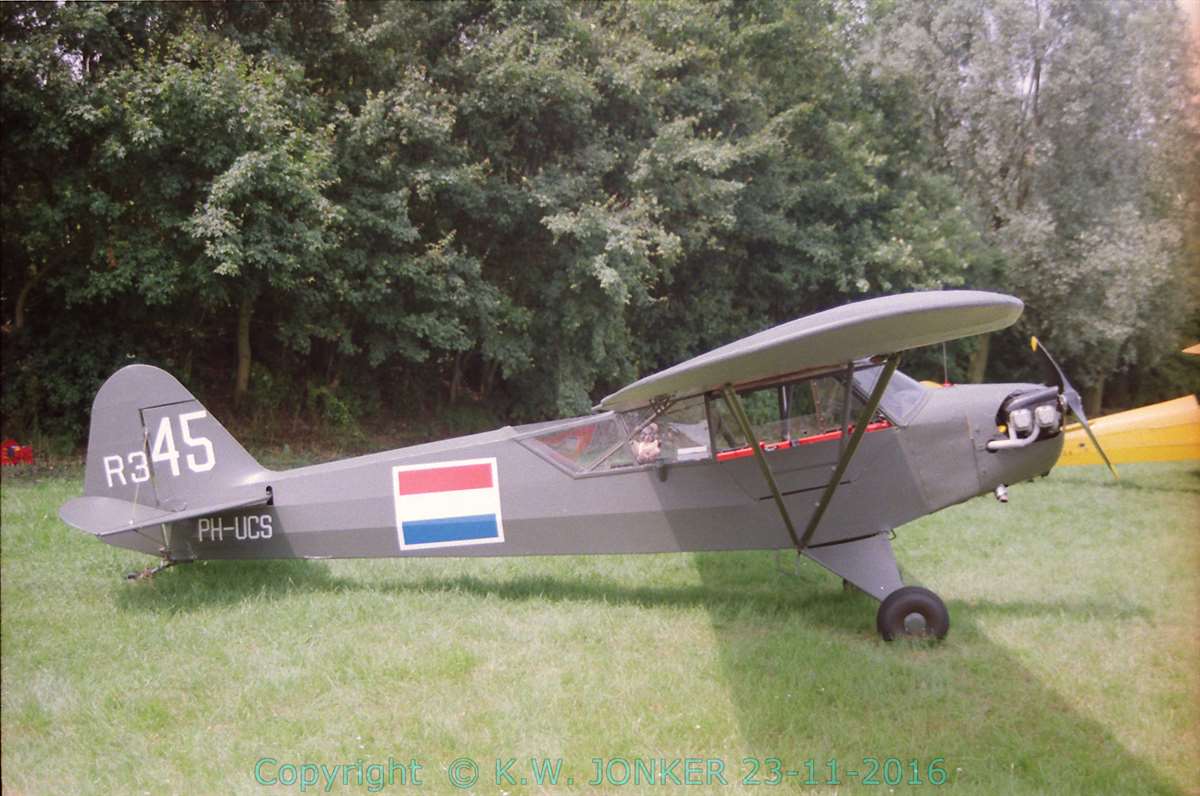
Piper L-4 Cub, PH-UCS, as R345, photographed at the Open Day Dutch Air Force, July 1994 at air base Leeuwarden.
These aircraft PK-SAA to PK-SAE received no ML-registration, but just the last letter of the civil registration (small) on the tip of the tail. Four aircraft went to the A-patrol and the fifth went to the detachment on Andir
The four devices on Tjililitan went in September 1946 on the VOS (Pre-training school), This took care for the selection of trainee pilots for ML-KNIl (NEIAF) from September 26, 1946 and on.
December 31, a new loan agreement for one year was agreed. In April 1947 it was agreed that the ML-KNIL (NEIAF) would take over the aircraft at the end of the loan period and would deliver five new aircraft to the BPM.
In July 1947, the five (former) BPM Pipers recieved the registrations R-329 to R-333.
In June 1946, 24 new aircraft were acquired from the US in Leyte, Philippines, including 30 radios, and initial stock parts. These arrived on 24 August in Surabaya, where four planes were unloaded, the remaining aircraft were sent to Batavia.
In April 1947 another 46 US aircraft were obtained, including five aircraft for BPM. These arrived on June 7, 1947 in Batavia. The most aircraft were transferred to Tjililitan. These Pipers were registered as R-335 to R-380.
| 1st Serial | Tweede Serial | Derde Serial | Vierde Serial | Vijfde Serial | Constr.nr. | US Fisc. year nr | Date in service | Date out of service | Notes |
|---|---|---|---|---|---|---|---|---|---|
| 1st series aircraft | |||||||||
| PC0-1 | PC0-001 | PC4-001 | PC-001 | R-301 | 13542 | 45-4802 | 09-1945 | 1950 | To Auris |
| PC0-2 | PC0-002 | PC4-002 | PC-002 | R-302 | 13538 | 45-4798 | 09-1945 | 01-03-1950 | To Auris |
| PC0-3 | PC0-003 | PC4-003 | PC-003 | R-303 | - | 09-1945 | 30-11-1946 | Written off Medan | |
| PC0-4 | PC0-004 | PC4-004 | PC-004 | R-304 | - | 11-1945 | 01-07-1947 | Written off te Bali | |
| Serial | 2nd Serial | Constr.nr. | US Fisc. Year no. | Date in service | Date out of service | Notes | |||
|---|---|---|---|---|---|---|---|---|---|
| Second series aircraft; on loan from BPM (later taken over) | |||||||||
| A | R-329 | 13320 | 45-4580 | 08-1946 | 01-03-1950 | PK-SAA; To Auris | |||
| B | R-330 | 13307 | 45-4567 | 08-1945 | 10-06-1950 | PK-SAB; To Auris | |||
| C | R-331 | 13295 | 45-4555 | 08-1946 | 1950 | PK-SAC; To Auris | |||
| D | R-332 | 13294 | 45-4554 | 08-1946 | 10-04-1950 | PK-SAD; To Auris | |||
| E | R-333 | 13311 | 45-4571 | 08-1946 | 04-1950 | PK-SAE; To Auris | |||
| Serial
Serial
|
2nd Serial
2nd Serial
|
Constr. nr.
Constr. nr.
|
US Fiscal Year nr.
US Fiscal Year nr.
|
Date in service
Date in service
|
Date out of service
Date out of service
|
Notes
Notes
|
|||
|---|---|---|---|---|---|---|---|---|---|
| Third series aircraft: bought in June 1946; Arrived on August 25 at Batavia. | |||||||||
| PC4-005 | R-305 | 13424 | 45-4684 | 25-08-1946 | 1950 | To Auris | |||
| PC4-006 | R-306 | 13460 | 45-4720 | 25-08-1946 | 10-06-1950 | To Auris | |||
| PC4-007 | R-307 | 13425 | 45-4685 | 25-08-1946 | 10-06-1950 | To Auris | |||
| PC4-007 | R-308 | 13418 | 45-4678 | 25-08-1946 | 10-06-1950 | To Auris | |||
| PC4-009 | R-309 | 13422 | 45-4682 | 25-08-1946 | 04-1950 | To Auris | |||
| PC4-010 | - | - | - | 25-08-1946 | 15-01-1947 | Written off Cianjur | |||
| PC4-011 | - | - | - | 25-08-1946 | 03-1947 | Written off | |||
| PC4-012 | R-312 | 13466 | 45-4726 | 25-08-1946 | 1950 | To Auris | |||
| PC4-013 | R-313 | 13358 | 45-4618 | 25-08-1946 | 04-1950 | To Auris | |||
| PC4-014 | R-314 | 13474 | 45-4734 | 25-08-1946 | 04-1950 | To Auris | |||
| PC4-015 | R-315 | 13411 | 45-4671 | 25-08-1946 | 1950 | To Auris | |||
| PC4-016 | R-316 | 13456 | 45-4716 | 25-08-1946 | 1950 | To Auris | |||
| PC4-017 | R-317 | 13454 | 45-4714 | 25-08-1946 | 10-06-1950 | To Auris | |||
| PC4-018 | R-318 | 13362 | 45-4622 | 25-08-1946 | 1950 | To Auris | |||
| PC4-019 | R-319 | 13440 | 45-4700 | 25-08-1946 | 1950 | To Auris | |||
| PC4-020 | - | - | - | 25-08-1946 | 31-3-1947 | Written off West-Java | |||
| PC4-021 | R-321 | 13337 | 45-4597 | 25-08-1946 | 1950 | To Auris | |||
| PC4-022 | R-322 | 13433 | 45-4693 | 25-08-1946 | 04-01-1949 | Written off | |||
| PC4-023 | R-323 | 13432 | 45-4692 | 25-08-1946 | 23-09-1947 | Written off Tandjung Balei | |||
| PC4-024 | R-324 | 13412 | 45-4672 | 25-08-1946 | 1950 | To Auris | |||
| PC4-025 | R-325 | 13449 | 45-4709 | 25-08-1946 | 04-1950 | To Auris | |||
| PC4-026 | R-326 | 13459 | 45-4719 | 25-08-1946 | 1950 | To Auris | |||
| PC4-027 | - | 13467 | 45-4727 | 28-08-1946 | 21-07-1947 | Written off Bandoeng | |||
| PC4-028 | R-328 | 13464 | 45-4724 | 28-08-1946 | 10-06-1950 | To Auris | |||
| Serial
Serial
|
Constr. nr.
Constr. nr.
|
US Fiscal Year nr.
US Fiscal Year nr.
|
Date in service
Date in service
|
Date out of service
Date out of service
|
Notes
Notes
|
||||
|---|---|---|---|---|---|---|---|---|---|
| Fourht series aircraft bought in April 1947 and arrived on June 7, 1947 at Batavia. | |||||||||
| R-335 | 13754 | 45-5014 | 07-06-1947 | 1950 | To Auris | ||||
| R-336 | 13755 | 45-5015 | 07-06-1947 | 12-05-1950 | To Auris | ||||
| R-337 | 13756 | 45-5016 | 07-06-1947 | 1950 | To Auris | ||||
| R-338 | 13757 | 45-5017 | 07-06-1947 | 07-11-1947 | Written off | ||||
| R-330 | 13761 | 45-5021 | 07-06-1947 | 21-01-1949 | Written off | ||||
| R-340 | 13762 | 45-5022 | 07-06-1947 | 1950 | To Auris | ||||
| R-341 | 13763 | 45-5023 | 07-06-1947 | 1950 | To Auris | ||||
| R-342 | 13764 | 45-5024 | 07-06-1947 | 1950 | To Auris | ||||
| R-343 | 13765 | 45-5025 | 07-06-1947 | 01-03-1950 | To Auris | ||||
| R-344 | 13766 | 45-5026 | 07-06-1947 | 10-06-1950 | To Auris | ||||
| R-345 | 13767 | 45-5027 | 07-06-1947 | 01-03-1950 | To Auris | ||||
| R-346 | 13768 | 45-5028 | 07-06-1947 | 01-07-1948 | As PK-SAF to aviation club Batavia | ||||
| R-347 | 13769 | 45-5029 | 07-06-1947 | 1950 | To Auris | ||||
| R-348 | 13770 | 45-5030 | 07-06-1947 | 05-1948 | Written off Medan | ||||
| R-349 | 13771 | 45-5031 | 07-06-1947 | 1950 | To Auris | ||||
| R-350 | 13772 | 45-5032 | 07-06-1947 | 12-05-1950 | To Auris | ||||
| R-351 | 13773 | 45-5033 | 07-06-1947 | 1950 | To Auris | ||||
| R-352 | 13774 | 45-5034 | 07-06-1947 | 1950 | To Auris | ||||
| R-353 | 13777 | 45-5037 | 07-06-1947 | 22-10-1949 | Written off | ||||
| R-354 | 13778 | 45-5038 | 07-06-1947 | 1950 | To Auris | ||||
| R-355 | 13779 | 45-5039 | 07-06-1947 | 1950 | To Auris | ||||
| R-356 | 13785 | 45-5045 | 07-06-1947 | 03-05-1948 | Written off | ||||
| R-357 | 13787 | 45-5047 | 07-06-1947 | 10-06-1950 | To Auris | ||||
| R-358 | 13789 | 45-5049 | 07-06-1947 | 1950 | To Auris | ||||
| R-369 | 13794 | 45-5054 | 07-06-1947 | 1950 | To Auris | ||||
| R-360 | 13796 | 45-5056 | 07-06-1947 | 28-10-1949 | Written off | ||||
| R-361 | 13797 | 45-5057 | 07-06-1947 | 1950 | To Auris | ||||
| R-362 | 13799 | 45-5059 | 07-06-1947 | 04-1950 | To Auris | ||||
| R-363 | 13802 | 45-5062 | 07-06-1947 | 1950 | To Auris | ||||
| R-364 | 13806 | 45-5066 | 07-06-1947 | 1950 | To Auris | ||||
| R-365 | 13808 | 45-5068 | 07-06-1947 | 1950 | To Auris | ||||
| R-366 | 13809 | 45-5069 | 07-06-1947 | 1950 | To Auris | ||||
| R-367 | 13810 | 45-5070 | 07-06-1947 | 03-02-1950 | To Auris | ||||
| R-368 | 13812 | 45-5072 | 07-06-1947 | 1950 | To Auris | ||||
| R-369 | 13815 | 45-5075 | 07-06-1947 | 04-1950 | To Auris | ||||
| R-370 | 13816 | 45-5076 | 07-06-1947 | 01-07-1948 | As PK-SAF to aviation club Batavia | ||||
| R-371 | 13817 | 45-5077 | 07-06-1947 | 20-06-1950 | To Auris | ||||
| R-372 | 13818 | 45-5078 | 07-06-1947 | 1950 | To Auris | ||||
| R-373 | 13819 | 45-5079 | 07-06-1947 | 13-05-1950 | To Auris | ||||
| R-374 | 13821 | 45-5081 | 07-06-1947 | 1950 | To Auris | ||||
| R-375 | 13823 | 45-5083 | 07-06-1947 | 1950 | To Auris | ||||
| R-376 | 13856 | 45-5116 | 07-06-1947 | 1950 | To Auris | ||||
| R-377 | 13861 | 45-5121 | 07-06-1947 | 1950 | To Auris | ||||
| R-378 | 13868 | 45-5128 | 07-06-1947 | 1950 | To Auris | ||||
| R-379 | 13883 | 45-5143 | 07-06-1947 | 1950 | To Auris | ||||
| R-380 | 13886 | 45-5146 | 07-06-1947 | 10-06-1950 | To Auris | ||||
1/72nd Scale
Kits
- Kovozávody Prostejov
- Kit 3146: Piper L4H Cub (wheels)
- Kit 3147: Piper L4H with Floats
- Kit 20.031: Piper L4H Cub (Wheels)
- Kit M7240: Piper L4A/B Cub (USAAF) [new mould by AZ Model]
- Kit M7243: Piper L4H/J Cub (French AF, RAAF, AURI, ML-KNIL) [new mould by AZ Model]
- Mastercraft
- Kit 3146: Same kit as KP: Piper L4H Cub (Wheels version)
Modelling add-on
- Kovozávody Prostejov
- Set EX006: Piper L4/K68 Cub Mask for Canopy and wheels (KP)
- Peewit
- Set M72021: Piper L-4 Canopy masking (Kovozávody Prostejov)
Decals
- Dutch Decal
- Set 72022: A decal set for several aircraft such as Piper L-4 Cub: R-371/R-345.
- Set 72067: Decals aircraft such as Fokker C.X; Lockheed Loestar; C-47 Dakota; Piper L4J; North American B-25 C, B-25J en B-25G Mitchell; Mitsubishi Ki-57 Topsy; Beech At-11 Kansan
1/48th Scale
Kits
- --
- Kit --: --
Modelling add-on
- --
- Set -: -
Decals
- Dutch Decal
- Set 72022: A decal set for several aircraft such as Piper L-4 Cub: R-371/R-345.
.
| Scheme | Colour name | FS-nummer | BS-nummer | Humbrol | XtraColor | Vallejo Model Color | Vallejo Model Air | |
|---|---|---|---|---|---|---|---|---|
| Standard #1 | Upper surfaces | Olive drab | 66 | X112 ANA 613 | 70.887 | |||
| Spots | mediumgreen | 149 | X114 Medium green | 70.895 | ||||
| Undersides | Grey | ~6173 | 156? | X132 | 70.992 | |||
Check www.paint4models.com for an extensive conversion table with lots of colour and paint systems.

The first scheme, overall (weathered) olive drab and neutral grey undersides with white rudder and, in red the aircraft number. Applied on e.g. PC-003 and PC-004.
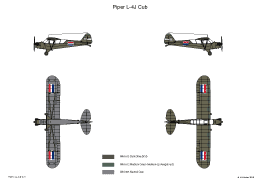
The second scheme, overall (weathered) olive drab and neutral grey undersides with flag with white border as national markings; serials on the vertical tail. Most aircraft had medium green spots on wings and tail (just like the US aircraft).
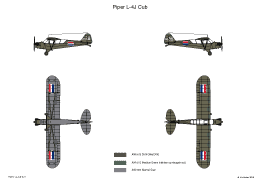
The third scheme, overall (weathered) olive drab and neutral grey undersides with flag with white border as national markings; new serials on the vertical tail. Most aircraft had medium green spots on wings and tail (just like the US aircraft).
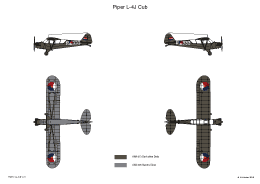
The fourth scheme, overall olive drab and neutral grey undersides with Dutch roundel as national markings and serial in white on the fuselage. (The aircraft seem to be overhauled and completely repainted, obivous no green spots were re-applied.)
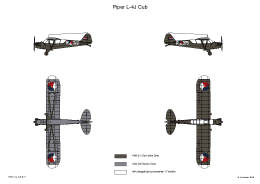
This scheme, which is identical to the previous paint scheme 4. Note the white wing tips, applied on aircraft of 17 VARWA, so it could be recognized easily by the Dutch fighter pilots
Literature.
| Army Co-operation bij de Militaire Luchtvaart in Indië 1946 - 1950 | P.C. Boer | 2004 | Sectie Luchtmachthistorie - 's Gravenhage | |
| Camouflage en Kentekens | J.Greuter e.a. | 1997 | Bonneville – Bergen (NH) | |
| Militaire Luchtvaart in Nederlandsch-Indië in beeld Deel 2 | Hugo Hooftman | Pag. 133 - 142 | 1981 | Uitgever: Europese Bibliotheek, Zaltbommel |
Websites.
Special thanks to M.T.A. Schep for the information which helped me a lot to produce and correct my initial colour schemes.
- Details
- Hits: 19770
History
Text about the development.
Versions.
Text about version.
| Dimensions: | |||
| Length: | 6,88 m | Wing span: | 10,74 m |
| Height: | - m | Wing area: | - m2 |
| Weights: | |||
| Empty Weight: | 381 kg | Max. start weight: | 794 kg |
| Performance: | |||
| Cruising speed: | - km/u | Max. speed: | 180 km/u |
| Climbing speed: | - m/min | ||
| Service ceiling: | 4572 m | Range: | 740 km |
| Miscellaneous: | |||
| Crew: | Two men | ||
| Engine type: | One Lycoming Continental C-90 rated 90 hp | ||
| Notes: | Piper PA-18-95 | ||
| Dimensions: | |||
| Length: | 6,8 m | Wing span: | 10,7 m |
| Height: | 1,9 m | Wing area: | 16,6 m2 |
| Weights: | |||
| Empty Weight: | 430 kg | Max. start weight: | 716 kg |
| Performance: | |||
| Cruising speed: | 185 km/u | Max. speed: | 198 km/u |
| Climbing speed: | - m/min | ||
| Service ceiling: | 6598 m | Range: | 1238 km |
| Miscellaneous: | |||
| Crew: | Two men | ||
| Engine type: | One Lycoming Continental O-290-D rated 125 hp | ||
| Notes: | Piper PA-18-125 | ||
| Dimensions: | |||
| Length: | 6,8 m | Wing span: | 10,7 m |
| Height: | 1,9 m | Wing area: | 16,6 m2 |
| Weights: | |||
| Empty Weight: | 430 kg | Max. start weight: | 793 kg |
| Performance: | |||
| Cruising speed: | - km/u | Max. speed: | 185 km/u |
| Climbing speed: | - m/min | ||
| Service ceiling | - m | Range: | 742 km |
| Miscellaneous: | |||
| Crew: | Two men | ||
| Engine type: | One Lycoming Continental O-320 rated 150 hp | ||
| Notes: | Piper PA-18-135 | ||
The Piper Super Cubs entered service during the fifties and replaced the Auster Mk. III, which was used for Army Observation and Liaison tasks.
The Pipers entered service with Squadron 298, 299 and 300 of Groep Lichte vliegtuigen (GPLV = Group Light Aircraft of the Duthc Army).
Also the type was used to train pilots for their 'Klein Militair Brevet' (elementary training). The training aircraft had an orange day-glo engine nacelle.
Further the Pipers were use by so called "maandvliegers" (monthly pilots), mainly staff officers who wanted to maintain their flying skills.
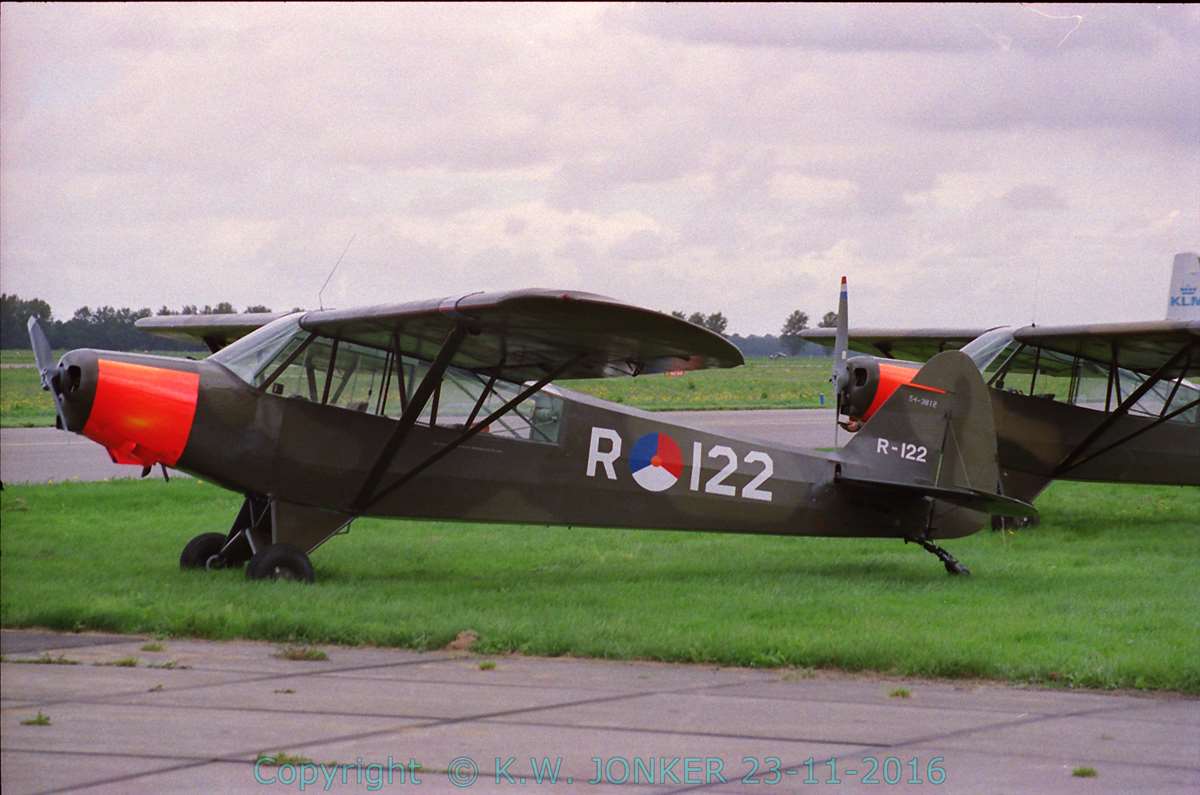
Piper Super Cub, R-122 from SKHV, photographed August 2002 at Airshow Lelystad..

Piper Super Cub, R-177 from SKHV, photographed August 2002 at Airshow Lelystad.
On Thunderstreaks.com you can find some photo's of aircraft of squadron no 300, such as the Piper Super Cub.
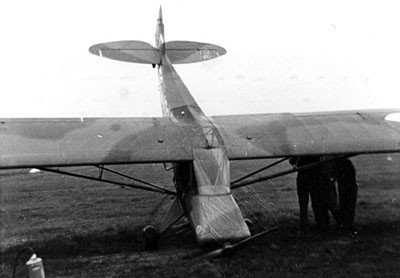
[Enclosed photo from BeeldBank NIMH. Click on photo for ordering information]

[Ingesloten foto van BeeldBank NIMH. Klik op de foto voor bestel-informatie]

[Enclosed photo from BeeldBank NIMH. Click on photo for ordering information]

[Enclosed photo from BeeldBank NIMH. Click on photo for ordering information]
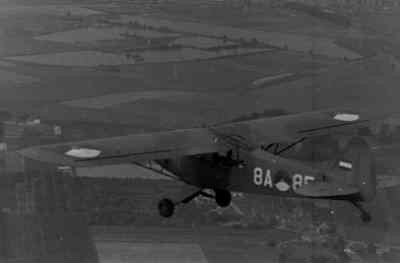
[Enclosed photo from BeeldBank NIMH. Click on photo for ordering information]

[Enclosed photo from BeeldBank NIMH. Click on photo for ordering information]

[Enclosed photo from BeeldBank NIMH. Click on photo for ordering information]

[Enclosed photo from BeeldBank NIMH. Click on photo for ordering information]
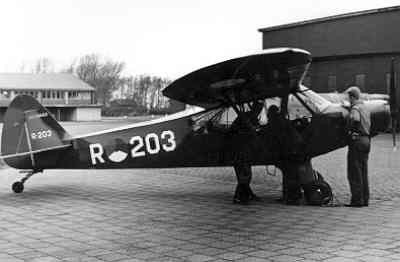
[Enclosed photo from BeeldBank NIMH. Click on photo for ordering information]

[Enclosed photo from BeeldBank NIMH. Click on photo for ordering information]
Serial overview Piper L-18C, Piper L-21A en Piper L-21B Super Cub
Serial overview Piper L-18C Super Cub
| Serial
Serial
| Fiscal Year nr.
Fiscal Year nr.
| Constr. nr.
Constr. nr.
| Date in service
Date in service
| Date out of service
Date out of service
| Notes
notes
|
|---|---|---|---|---|---|
| R-30 | 52-2427 | 18-2027 | Written off | ||
| R-31 | 52-2428 | 18-2028 | Written off | ||
| R-32 | 52-2429 | 18-2029 | Written off | ||
| R-33 | 52-2430 | 18-2030 | To Germany as D-EMAD | ||
| R-34 | 52-2431 | 18-2031 | To Germany as D-ELIH | ||
| R-35 | 52-2432 | 18-2032 | To Germany as D-ENWO | ||
| R-36 | 52-2433 | 18-2033 | To Germany as D-ENLC | ||
| R-37 | 52-2434 | 18-2034 | To Germany as D-EMOR | ||
| R-38 | 52-2435 | 18-2035 | |||
| R-39 | 52-2437 | 18-2037 | To Germany as D-EMAM | ||
| R-40 | 52-2445 | 18-2045 | Type L-18C-PI; became PH-WJK, later to England as G-BAFV | ||
| R-41 | 52-2449 | 18-2049 | Became LX-AIT | ||
| R-42 | 52-2451 | 18-2051 | Type L-18C-PI; Became LN-KCO | ||
| R-43 | 52-2436 | 18-2036 | Type L-18C-PI; Became PH-NLF | ||
| R-44 | 52-2450 | 18-2050 | Type L-18C-PI; To Germany as D-EMKE | ||
| R-45 | 52-2452 | 18-2052 | Type L-18C-PI; Became PH-NLB, later OO-SPE, later to England as G-AXLZ | ||
| R-46 | 52-2438 | 18-2038 | Type L-18C-PI; Became LN-KCP | ||
| R-47 | 52-2439 | 18-2039 | Written off | ||
| R-48 | 52-2442 | 18-2042 | Became LN-KCR | ||
| R-49 | 52-2443 | 18-2043 | To Germany as D-EMOD | ||
| R-50 | 52-2446 | 18-2046 | Became PH-JWK | ||
| R-51 | 52-2447 | 18-2047 | Became PH-NLE, later to England as G-AXGA | ||
| R-52 | 52-2448 | 18-2048 | Type L-18C-PI; To Germany as D-EMVY | ||
| R-53 | 52-2460 | 18-2060 | Became OO-SPG | ||
| R-54 | 52-2461 | 18-2061 | Became LN-KCS | ||
| R-55 | 52-2466 | 18-2066 | Type L-18C-PI; To Germany as D-ENWI | ||
| R-56 | 52-2467 | 18-2067 | Written off | ||
| R-57 | 52-2468 | 18-2068 | Written off | ||
| R-58 | 52-2469 | 18-2069 | Became LN-KCT | ||
| R-59 | 52-2470 | 18-2070 | Became OO-SPH | ||
| R-60 | 52-2471 | 18-2071 | Written off | ||
| R-61 | 52-2472 | 18-2072 | To Germany as D-ENAN | ||
| R-62 | 52-2473 | 18-2073 | Became PH-GAL | ||
| R-63 | 52-2474 | 18-2074 | Written off | ||
| R-64 | 52-2475 | 18-2075 | To France as F-BNLR | ||
| R-65 | 52-2476 | 18-2076 | Type L-18C-PI; Became PH-WAN, OO-WAN, PH-WAN | ||
| R-66 | 52-2441 | 18-2041 | Type L-18C-PI; To Germany as D-ENAS | ||
| R-67 | 52-2444 | 18-2044 | Became PH-NLG | ||
| R-68 | 52-2453 | 18-2053 | Became LN-KCU, later PH-LUF | ||
| R-69 | 52-2454 | 18-2054 | Type L-18C-PI; Became LN-KCV | ||
| R-70 | 52-2455 | 18-2055 | Type L-18C-PI; Became OO-SPF | ||
| R-71 | 52-2456 | 18-2056 | To Germany as D-ENAW | ||
| R-72 | 52-2457 | 18-2057 | Type L-18C-PI; Became PH-NLD | ||
| R-73 | 52-2458 | 18-2058 | Became PH-JKB | ||
| R-74 | 52-2459 | 18-2059 | Type L-18C-PI; Became LN-KCW | ||
| R-75 | 52-2440 | 18-2040 | To France as F-BNLQ | ||
| R-76 | 52-2462 | 18-2062 | Type L-18C-PI; Became LN-KCX | ||
| R-77 | 52-2463 | 18-2063 | Written off | ||
| R-78 | 52-2464 | 18-2064 | Written off | ||
| R-79 | 52-2465 | 18-2065 | Type L-18C-PI; Became PH-CWA | ||
| R-80 | 53-4778 | 18-3178 | ex OL-L104; Written off | ||
| R-81 | 53-4779 | 18-3179 | ex OL-L105; Became PH-ALM | ||
| R-82 | 53-4780 | 18-3180 | ex OL-L106; Became PH-VCU | ||
| R-83 | 53-4781 | 18-3181 | Type L-18C-PI; ex OL-L107; Became PH-VCV | ||
| R-84 | 53-4782 | 18-3182 | ex OL-L108; To Germany as D-ECQA | ||
| R-85 | 53-4783 | 18-3183 | ex OL-L109; Became PH-JFF, later PH-VCU | ||
| R-86 | 53-4784 | 18-3184 | ex OL-L1 10; To Germany as D-EDVO | ||
| R-87 | 53-4785 | 18-3185 | ex OL-L1 11; Preserved | ||
| R-88 | 53-4786 | 18-3186 | ex OL-L1 12; Became PH-WAL, latr PH-VCW |
Serial overview Piper L-21A Super Cub
| Serial
Serial
| Fiscal Year nr.
Fiscal Year nr.
| Constr. nr.
Constr. nr.
| Date in service
Date in service
| Date out of service
Date out of service
| Notes
notes
|
|---|---|---|---|---|---|
| R 206 | 51-15658 | 18-1658 | Used for spare parts | ||
| R-201 | 51-15685 | 18-1685 | 1969 | To Germany as D-EETT | |
| R-202 | 51-15681 | 18-1681 | 1969 | To Germany as D-EEWO | |
| R-203 | 51-15683 | 18-1683 | 1969 | To PH-KAW | |
| R-204 | 51-15687 | 18-1687 | 1969 | To PH-GAI | |
| R-205 | 51-15686 | 18-1686 | 1969 | To PH-VCX | |
| R-207 | 51-15672 | 18-1672 | Written off | ||
| R-208 | 51-15673 | 18-1673 | 1969 | Became PH-GAV | |
| R-209 | 51-15674 | 18-1674 | 1969 | Written off | |
| R-210 | 51-15678 | 18-1678 | 1969 | To Germany as D-EGJN | |
| R-211 | 51-15679 | 18-1679 | Written off | ||
| R-212 | 51-15680 | 18-1680 | 1969 | Became OO-VZL | |
| R-213 | 51-15682 | 18-1682 | Preserved for museum | ||
| R-214 | 51-15684 | 18-1684 | 1969 | Became PH-KAZ | |
| R-215 | 51-15690 | 18-1690 | 26-10-1966 | Written off | |
| R-216 | 51-15691 | 18-1691 | 1969 | Became PH-GAT | |
| R-217 | 51-15692 | 18-1692 | 1969 | Became PH-LUC | |
| R-218 | 51-15693 | 18-1693 | Written off |
Serial overview Piper L-21B Super Cub
| Serial
Serial
| Fiscal Year nr.
Fiscal Year nr.
| Constr. nr.
Constr. nr.
| Date in service
Date in service
| Date out of service
Date out of service
| Notes
notes
|
|---|---|---|---|---|---|
| R-101 | 54-2329 | 18-3529 | Written off | ||
| R-102 | 54-2330 | 18-3530 | Written off | ||
| R-103 | 54-2331 | 18-3531 | Type L-21B-PI | ||
| R-104 | 54-2332 | 18-3532 | |||
| R-105 | 54-2333 | 18-3533 | |||
| R-106 | 54-2334 | 18-3534 | |||
| R-107 | 54-2335 | 18-3535 | Type L-21B-PI; Became PH-DKE | ||
| R-108 | 54-2336 | 18-3536 | |||
| R-109 | 54-2337 | 18-3537 | Became PH-GAZ | ||
| R-110 | 54-2338 | 18-3538 | 09-08-1973 | Written off | |
| R-111 | 54-2401 | 18-3801 | |||
| R-112 | 54-2402 | 18-3602 | Type L-21B-PI; Became PH-DKC | ||
| R-113 | 54-2403 | 18-3803 | To Belgium as LB-01 | ||
| R-114 | 54-2404 | 18-3804 | Stored | ||
| R-115 | 54-2405 | 18-3805 | Stored | ||
| R-116 | 54-2406 | 18-3806 | |||
| R-117 | 54-2407 | 18-3807 | Stored | ||
| R-118 | 54-2408 | 18-3808 | To Belgium as LB-02 | ||
| R-119 | 54-2409 | 18-3809 | 20-07-1969 | Written off | |
| R-120 | 54-2410 | 18-3810 | Stored | ||
| R-121 | 54-241 1 | 18-3811 | 07-07-1967 | Written off | |
| R-122 | 54-2412 | 18-3812 | |||
| R-123 | 54-2413 | 18-3813 | |||
| R-124 | 54-2414 | 18-3814 | Became PH-APA | ||
| R-125 | 54-2415 | 18-3815 | Written off | ||
| R-126 | 54-2416 | 18-3816 | Stored | ||
| R-127 | 54-2417 | 18-3817 | Became PH-DKB | ||
| R-128 | 54-2418 | 18-3818 | |||
| R-129 | 54-2419 | 18-3819 | |||
| R-130 | 54-2420 | 18-3820 | Type L-21B-PI; Stored | ||
| R-131 | 54-2421 | 18-3821 | Stored | ||
| R-132 | 54-2422 | 18-3822 | Stored | ||
| R-133 | 54-2423 | 18-3823 | |||
| R-134 | 54-2424 | 18-3824 | Became PH-WAC, PH-USA | ||
| R-135 | 54-2425 | 18-3825 | Became OO-TAN | ||
| R-136 | 54-2426 | 18-3826 | Stored | ||
| R-137 | 54-2427 | 18-3827 | 18-07-1974 | Written off | |
| R-138 | 54-2428 | 18-3828 | Type L-21B-PI; Stored | ||
| R-139 | 54-2429 | 18-3829 | |||
| R-140 | 54-2430 | 18-3830 | Temporarily used as PH-VCH; to MLD | ||
| R-149 | 54-2439 | 18-3839 | Temporarily used as PH-RDM; Stored | ||
| R-150 | 54-2440 | 18-3840 | Stored | ||
| R-151 | 54-2441 | 18-3841 | Became PH-GER | ||
| R-152 | 54-2442 | 18-3842 | To Belgium as LB-03 | ||
| R-153 | 54^2443 | 18-3843 | To Belgium as LB-04 | ||
| R-154 | 54-2444 | 18-3844 | To Belgium as LB-05 | ||
| R-155 | 54-2445 | 18-3845 | Became OO-TAN | ||
| R-156 | 54-2446 | 18-3846 | Type L-21B-PI; to MLD; Became later PH-DKF | ||
| R-157 | 54-2447 | 18-3847 | Type L-21B-PI; Became PH-GAX | ||
| R-158 | 54-2448 | 18-3848 | Stored | ||
| R-159 | 54-2449 | 18-3849 | Stored | ||
| R-160 | 54-2450 | 18-3850 | Stored | ||
| R-161 | 54-2451 | 18-3851 | Stored | ||
| R-162 | 54-2452 | 18-3852 | Became PH-WDR, later PH-LET | ||
| R-163 | 54-2453 | 18-3853 | Type L-21B-PI; Became PH-LET | ||
| R-164 | 54-2454 | 18-3854 | Became PH-DKA | ||
| R-165 | 54-2455 | 18-3855 | Temporarily used as PH-CWA; Stored | ||
| R-166 | 54-2456 | 18-3856 | Became PH-AVE | ||
| R-167 | 54-2457 | 18-3857 | Type L-21B-PI; Became PH-DKG | ||
| R-168 | 54-2458 | 18-3858 | 08-01-1961 | Written off | |
| R-169 | 54-2459 | 18-3659 | Became PH-ZCT | ||
| R-170 | 54-2460 | 18-3660 | Became PH-WAS | ||
| R-171 | 54-2461 | 18-3661 | Became PH-JEB | ||
| R-172 | 54-2462 | 18-3662 | Stored | ||
| R-173 | 54-2463 | 18-3663 | Became PH-DKH | ||
| R-174 | 54-2464 | 18-3664 | To Belgium as LB-06 | ||
| R-175 | 54-2465 | 18-3665 | Currently in use as PH-ZCR at private air strip at Slootdorp | ||
| R-176 | 54-2466 | 18-3666 | Became PH-TIN | ||
| R-177 | 54-2467 | 18-3667 | Stored | ||
| R-178 | 54-2468 | 18-3668 | Became PH-VHO | ||
| R-179 | 54-2469 | 18-3669 | Became PH-WDT | ||
| R-180 | 54-2470 | 18-3670 | 10-06-1966 | Written off | |
| R-181 | 54-2471 | 18-3671 | 02-07-1975 | Written off; Became PH-GAU | |
| R-182 | 54-2472 | 18-3672 | Stored | ||
| R-183 | 54-2473 | 18-3673 | Stored | ||
| R-184 | 54-2474 | 18-3674 | Stored | ||
| R-185 | 54-2475 | 18-3675 | Written off | ||
| R-186 | 54-2476 | 18-3676 | Stored |
1/72nd Scale
Kits
- Airmodel
- Kit AM034: A vacu formed model of a Piper PA-18/L-18 Super Cub (it is said it looks more like a Piper Cub though)
- BroPlan
- Kit MS84: Piper L-21 Super Cub (Swedish AF)
- Kit MS82: Piper L-18C Super Cub (Danish AF, Norway AF, Luftwaffe, KLu)
- Czechmaster
- Kit 173: A resin kit of a Piper L18C Super Cub
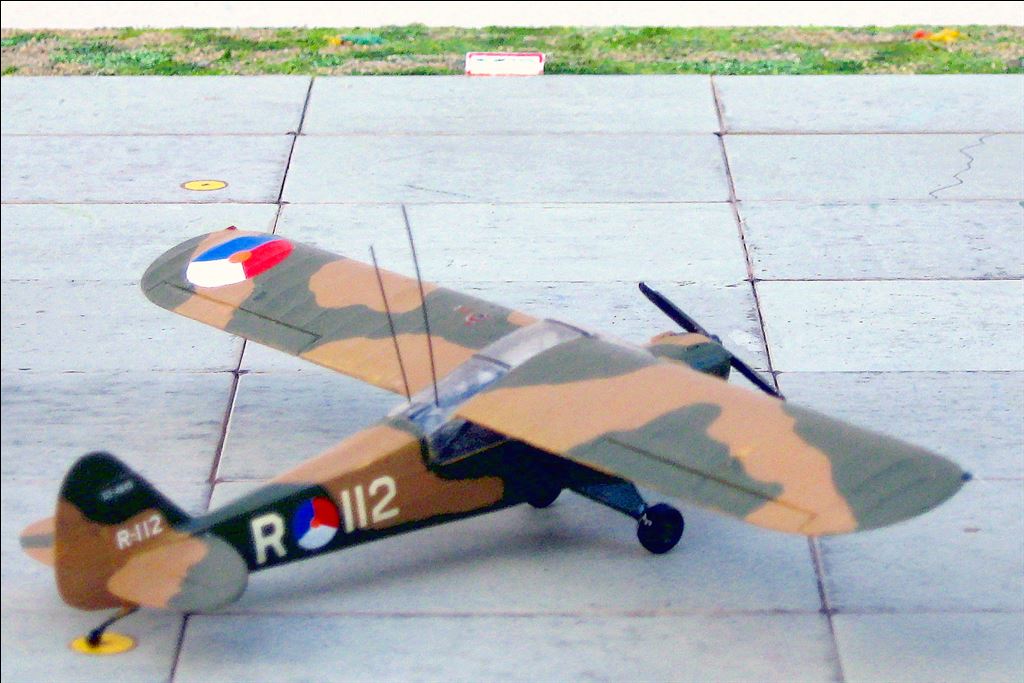
Modelling add-on
- --
- Set --: --
Decals
- --
- Set --: --
Scale 1/48
Kits
- Minicraft
- Kit 11611: Piper Super Cub
- Kit 11650: Piper L21 Super Cub (USArmy, Luftwaffe)
Modelling add-on
- --
- Set -: -
Decals
- --
- Set -: --
| Scheme | Colour name | FS number | BS number | Humbrol | XtraColor | Vallejo Model Color | Vallejo Model Air | |
|---|---|---|---|---|---|---|---|---|
| Standard #1: squadron-serials | Overall | Yellow | BS:356 | 154 | X213 | 70.953 | 71.078 | |
| Standard #2: Camouflage pattern varies. | Overall | Khaki | BS:450 | 29 | X002 | 70.921 | ||
| Dark Green | 116 | X116 | 70.893 | 71.016 | ||||
Check www.paint4models.com for an extensive conversion table with lots of colour and paint systems.

Much variation in the applied camouflage pattern occurs.
Shown is the pattern according tot official drawings.
Literature.
| Van Brik tot Starfighter | H. Hooftman | 1965 | La Rivière en Voorhoeve - Zwolle | |
| Dutch Military Aviation 1945-1978 | Paul A. Jackson | Pag. 96; 106; 113 | 1978 | Uitgever: Midland Countries Publications, Leicester |
| Nederlandse Militaire Luchtvaart in Beeld. deel 2 | Hugo Hooftman | Pag. 118 - 123 | 1978 | Uitgever: Europese Bibliotheek, Zaltbommel |
| Squadrons van de Koninklijke Luchtmacht | Willem Helfferich | Pag. 57 - 58; 63 | 1983 | Uitgever: Unieboek b.v., Houten |
| KLu Vliegtuigen: De vliegtuigen van de Koninklijke Luchtmacht vanaf 1913 | Wim Schoenmaker & Thijs Postma | Pag. 114 | 1987 | Uitgeverij De Alk, Alkmaar |
| Van Luchtvaartafdeling tot Koninklijke Luchtmacht 75 jaar Militaire Luchtvaart in Nederland | Koos van de Berg | Pag. 50 | 1988 | Uitgever: Rebo Produkties, Sassenheim |
| Squadrons van de Koninklijke Luchtmacht (derde herzien druk) | Willem Helfferich | Pag. 33 | 1994 | Uitgevers Wyt, Rotterdam |
| Camouflage en Kentekens | J.Greuter e.a. | 1997 | Bonneville – Bergen (NH) |
Websites.
Special thanks to mr P. Patist for the corrections regarding R-123.
- Details
- Hits: 13228
History
The Pilatus PC-7 is based on the Pilatus P-3 and the first prototype, actually a P-3 of which the Lycoming engine was replaced by a P & W PT6A-20 turboprop, made its first flight in April 1966.
The program was seriously delayed by a crash and just in 1975 a second prototype, also a converted P-3, made its maiden flight.
There were all kinds of modifications, such as a new wing with integrated fuel tanks, a modified tail and a tear drop cockpit.
In August 1978 the first production exampled rolled out and by the end of the year, the type received its Swiss type certification.
Soon the delivery of the PC-7 to both civilian and military users followed.
The PC-7 Mk. II is actually a development of the PC-9, and adapted to the smaller of the turboprop PC-7. Goal was reducing the cost of operation and maintenance.
Versions.
- PC-7:
- two seat basic trainer with one Pratt & Whitney PT6A-25A rated 410 kW
- PC-7 Mk II:
- a development for the SAAF, based on the airframe and avionics of the PC-9, the wing of the PC-7 and one& Pratt & Whitney PT6A-25C rated 522 kW. In fact it is a hybrid of the PC-7 and the PC-9.
- NCPC-7:
- an upgraded version, developed for the Swiss air force and equipped with a glass cockpit and new avionics.
| Dimensions: | |||
| Length: | 9,78 m | Wingspan: | 10,4 m |
| Height: | 3,21 m | Wing area: | 16,3 m2 |
| Weights: | |||
| Empty weight: | 1670 kg | Max. start weight: | 2700 kg |
| Performances: | |||
| Max. speed: | 500 km/hr | Climbing speed: | - m/min |
| Cruising speed: | 412 km/hr | ||
| Range: | 1050 km | Service ceiling: | 10060 m |
| Miscellaneous: | |||
| Engine type: | One Pratt & Whitney PT-6A-25A rated 650 hp | ||
| Crew: | One instructor plus one pupil | ||
| Armament: | None | ||
Since 1989 the Royal Netherlands Air Force operates thirteen Pilatus PC-7 Turbo Trainers for the flying training at Woensdrecht at the EMVO (Elementary Military Flying School). At first ten aircraft were bought, since 1997 three additional aircraft were bought added.
Since 1995 a standard Pilatus PC-7 is used for display purposes at several events both in the Netherlands and abroad. The team uses two smoke pods under the wings.
It uses two aircraft, one operational demonstration aircraft plus one spare.

Pilatus L-02, photographed at de Open Day Dutch Air Force, July 1997 at airbase Gilze-Rijen.
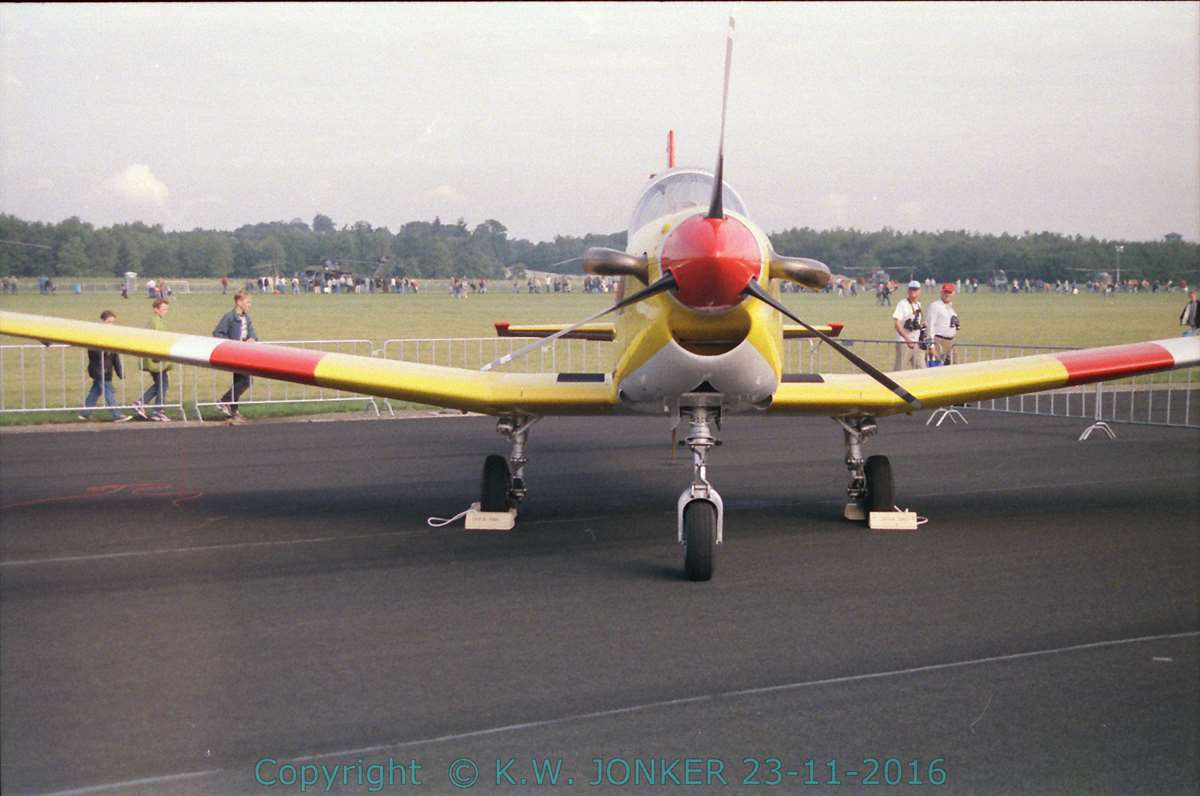
Pilatus L-02, photographed at de Open Day Dutch Air Force, July 1997 at airbase Gilze-Rijen.

Pilatus L-10, photographed at de Open Day Dutch Air Force, July 1998 at airbase Leeuwarden.
In 2006 the aircraft had a new paint scheme overall gloss black with yellow markings applied. The black colour was because of an improved visibility in the air.
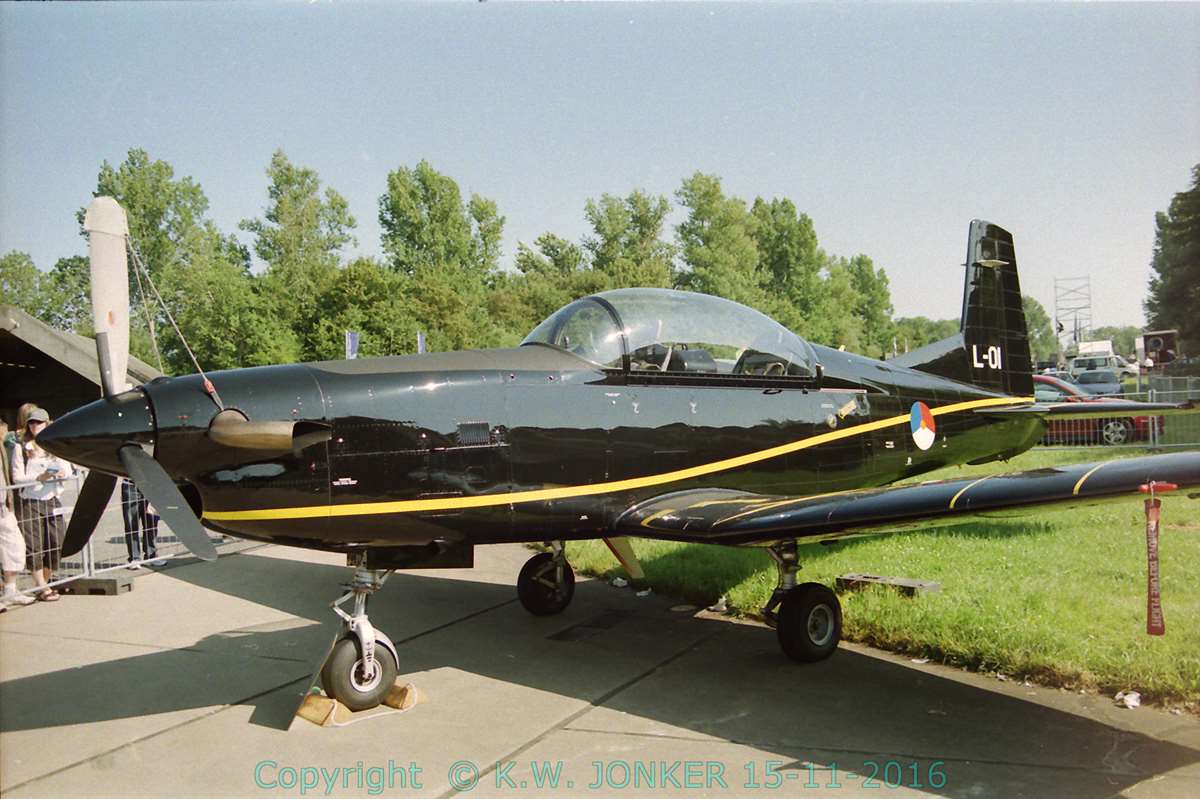
Pilatus L-01 in the new paint scheme, photographed at de Open Day Dutch Air Force, June 2006 at airbase Leeuwarden.
A walk-around of the PC-7; photographed at de Open Day Dutch Air Force, June 2009 at airbase Volkel.

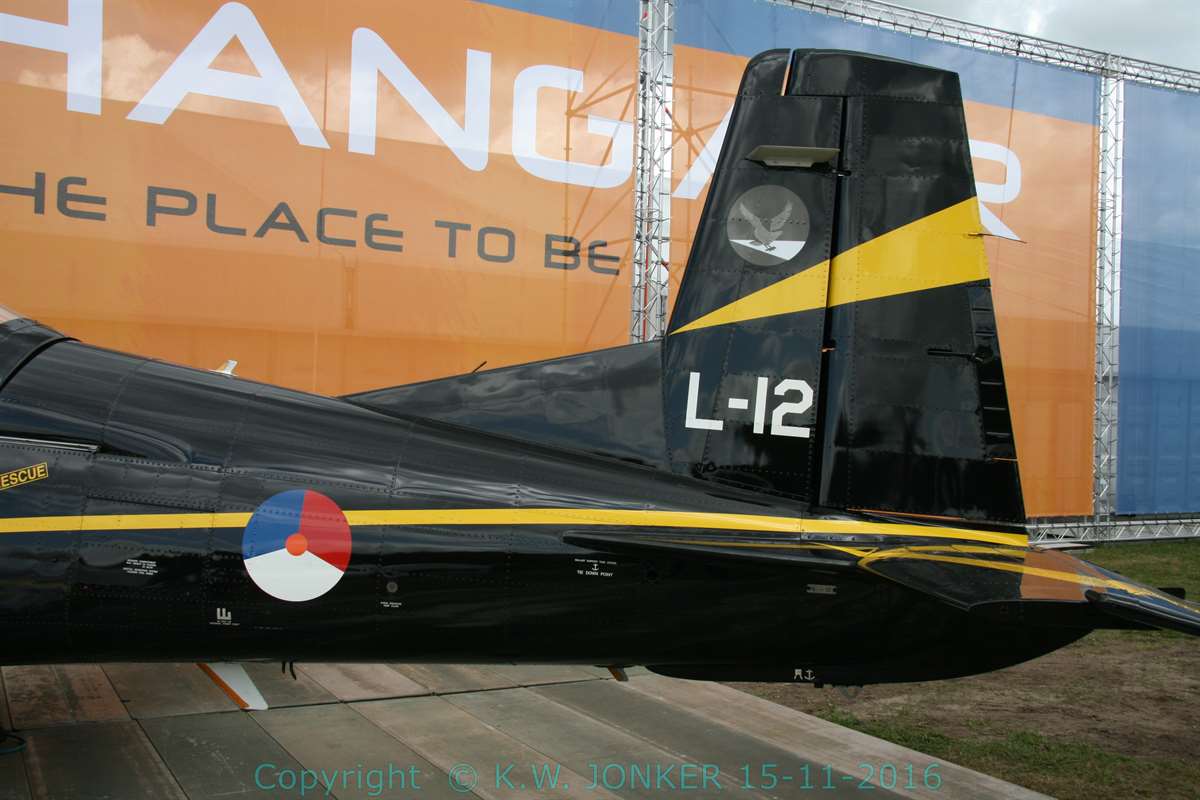
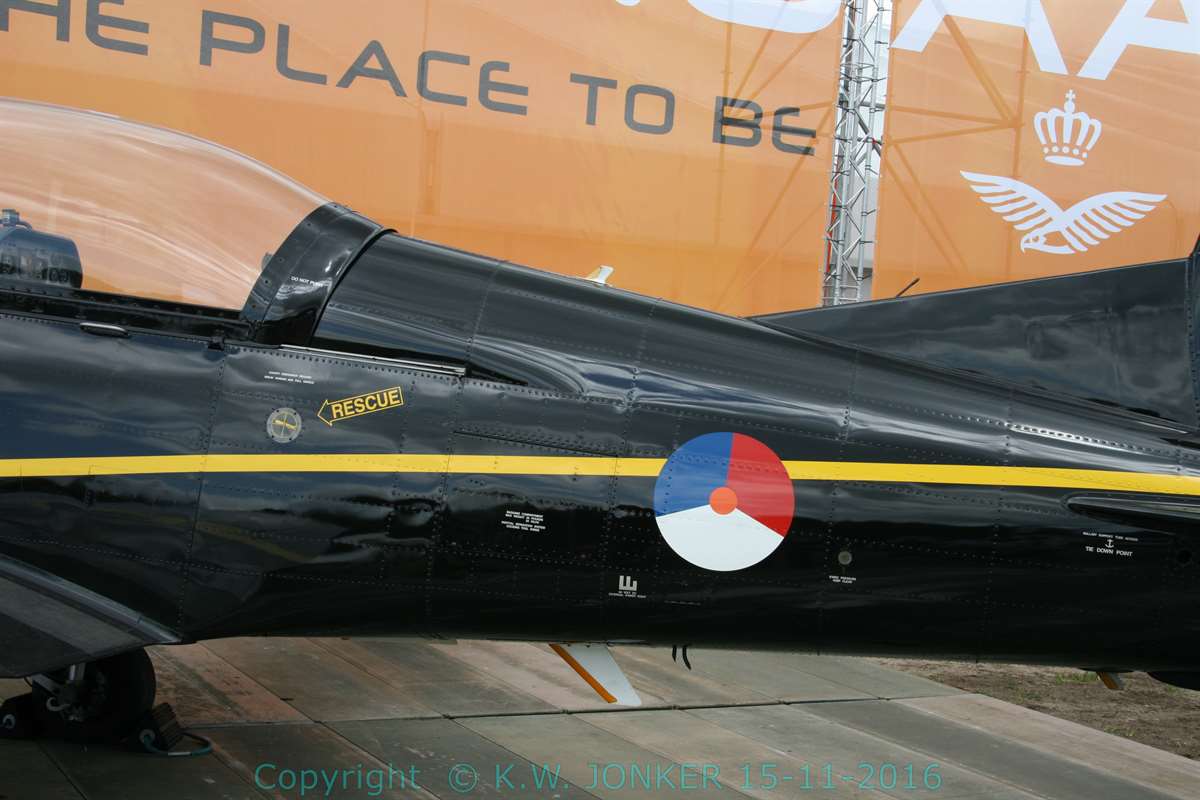
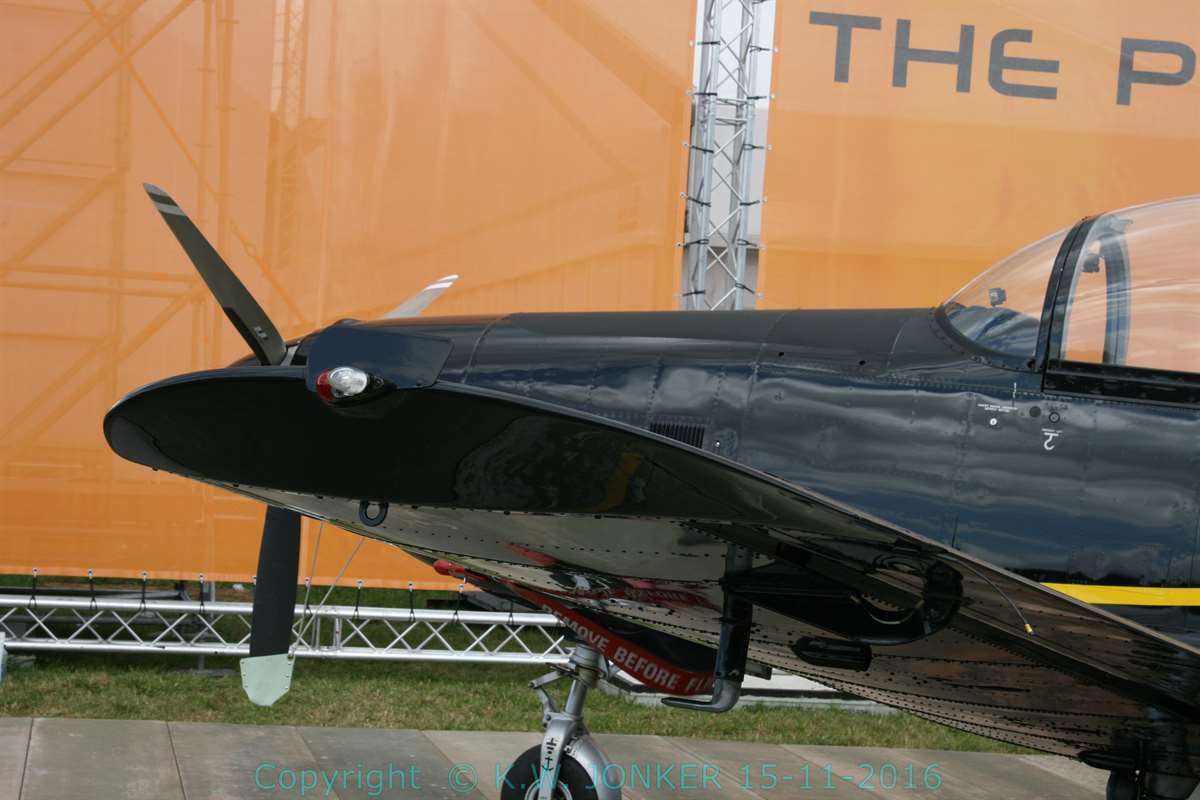
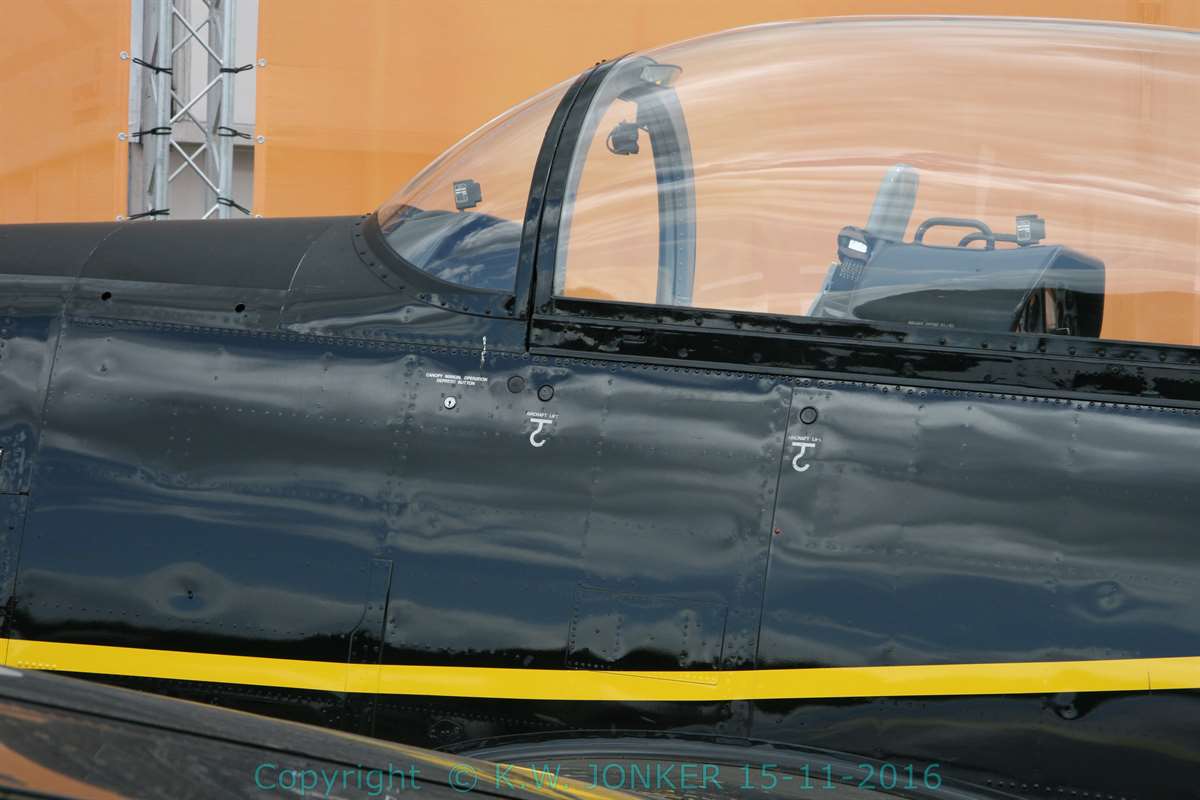





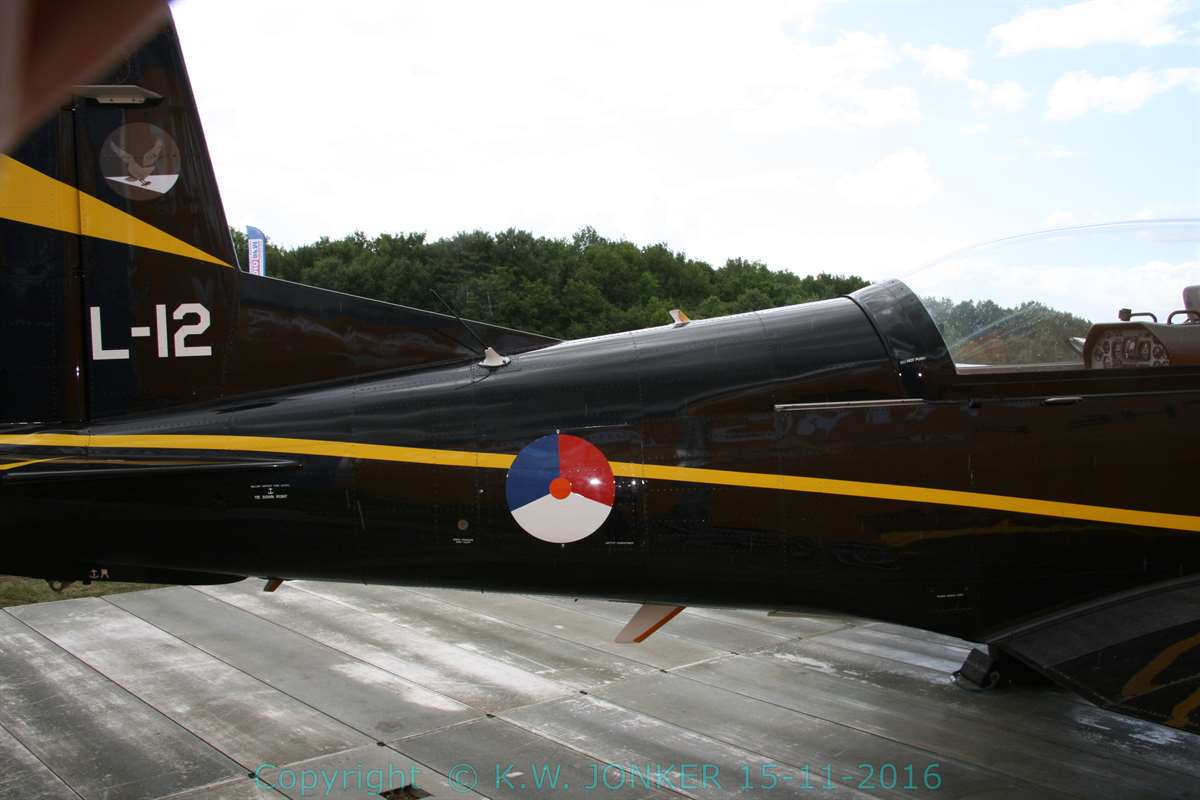
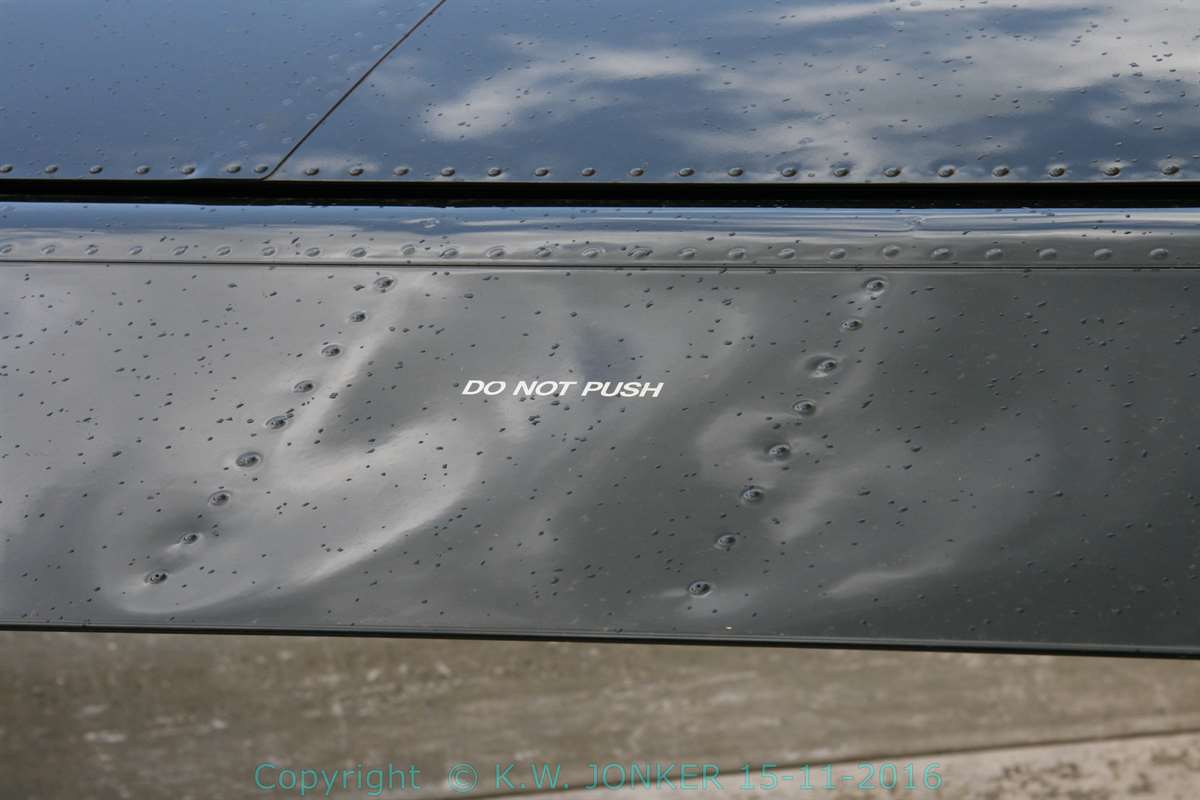
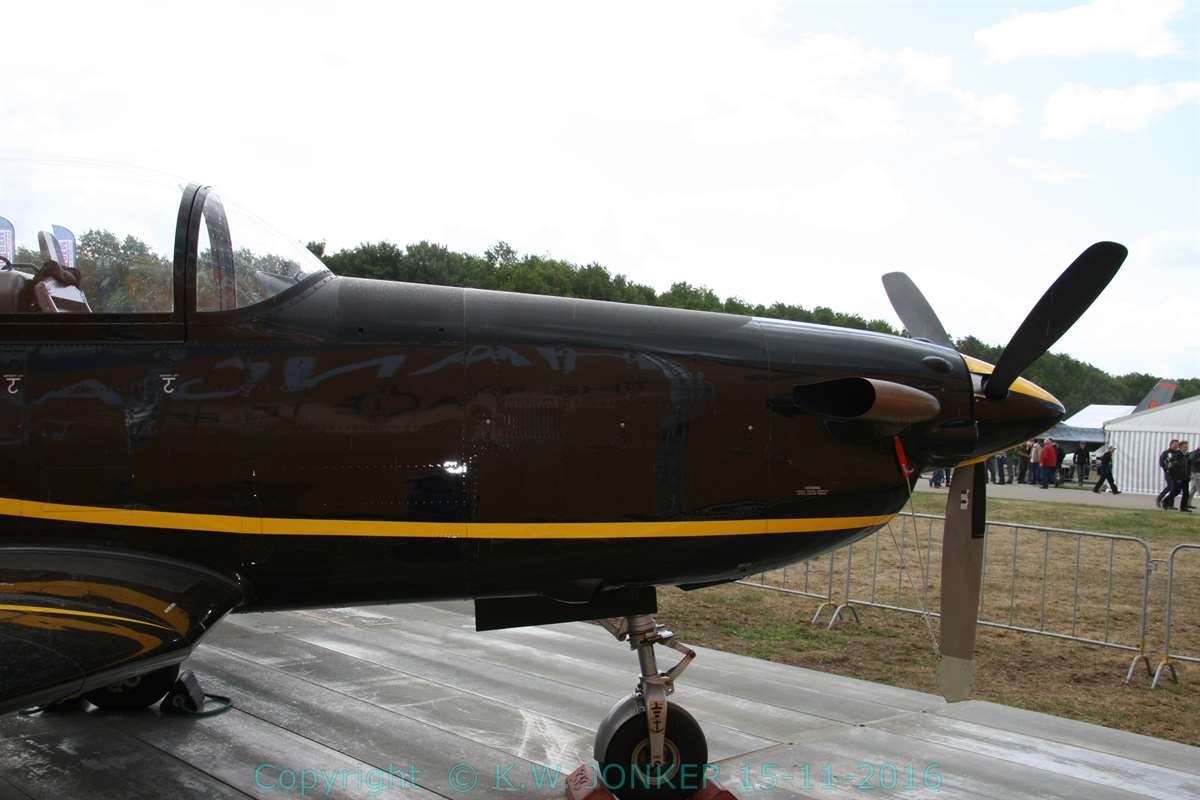
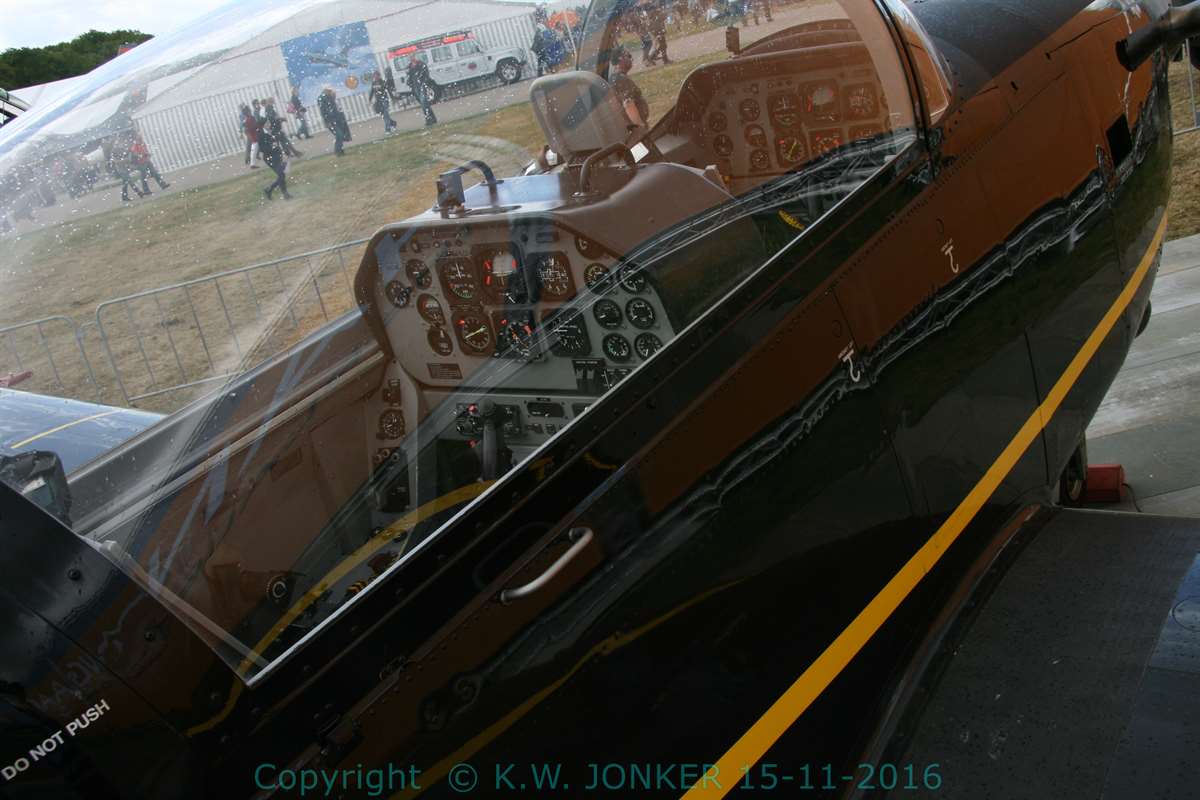
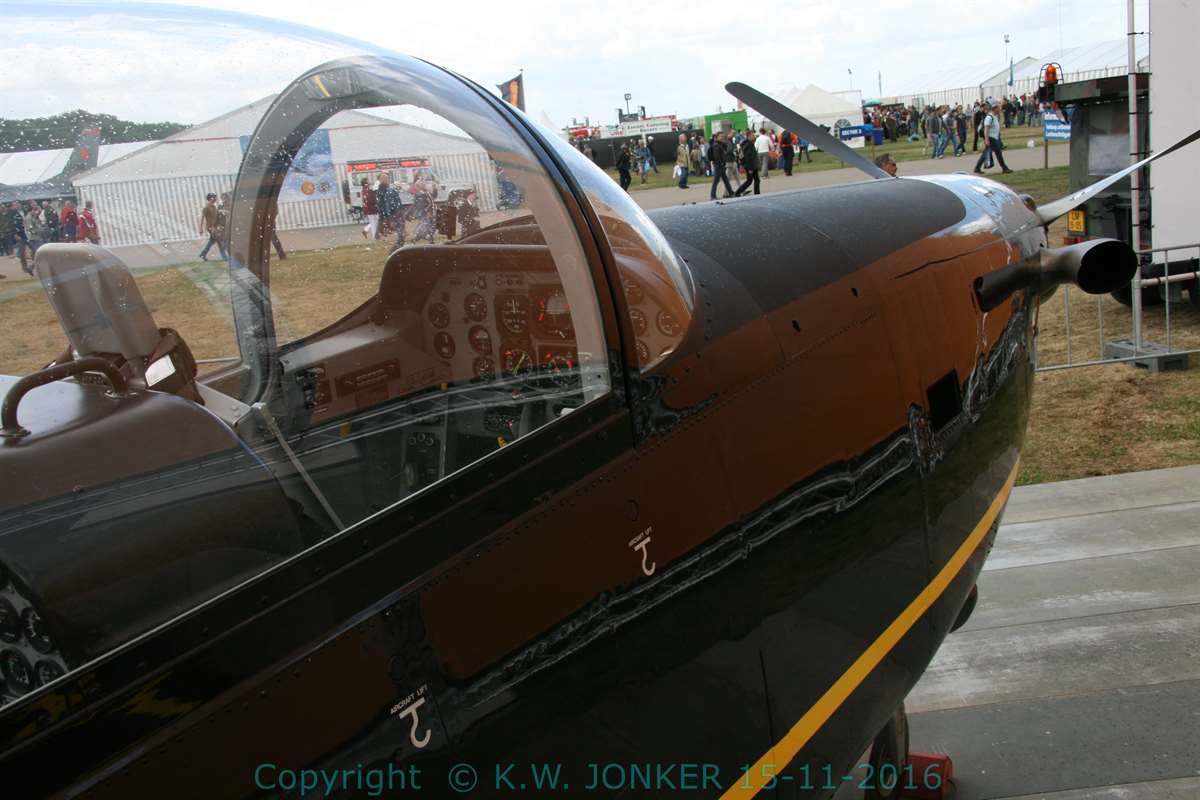
| Serial
Serial
| Constr. nr.
Constr. nr.
| Date in service
Date in service
| Date out of service
Date out of service
| Notes
notes
|
|---|---|---|---|---|
| L-01 | 538 | 26-01-1989 | Was HB-HCM | |
| L-02 | 539 | 26-01-1989 | Was HB-HLV | |
| L-03 | 540 | 27-01-1989 | Was HB-HLW | |
| L-04 | 541 | 27-01-1989 | Was HB-HLX | |
| L-05 | 542 | 09-03-1989 | Was HB-HLY | |
| L-06 | 543 | 09-03-1989 | Was HB-HLZ | |
| L-07 | 544 | 22-05-1989 | Was HB-HAN | |
| L-08 | 545 | 18-06-1989 | Was HB-HAP | |
| L-09 | 546 | 10-08-1989 | Was HB-HAQ | |
| L-10 | 547 | 14-09-1989 | Was HB-HAR | |
| L-11 | 610 | 11-07-1997 | ||
| L-12 | 611 | 11-07-1997 | ||
| L-13 | 612 | 11-07-1997 |
1/72nd Scale
Kits
- Aeroclub
- Kit K022 / K026: Short run kit Pilatus PC7 (KLu, Mexican AF, Chilean Navy) / Pilatus PC7 (Swiss AF,Burma AF, Bolivia AF)
- Planet
- Kit 195: A resin kit for a Pilatus PC7 Turbo Trainer; Kit contains vacu canopy and decals for Dutch and Swiss aircraft The smoke pods of the Dutch Demoplanes are also included
- Scaleworx Resin models
- Kit 72-10: Pilatus PC7 Mk.II Astra (SAAF) [note: This model is NOT suited for a Dutch version of the PC-7!]
- Spinner Models
- Kit XX: Pilatus PC7 Mk.II Astra (SAAF) [note: This model is not suited for a Dutch version of the PC-7!]
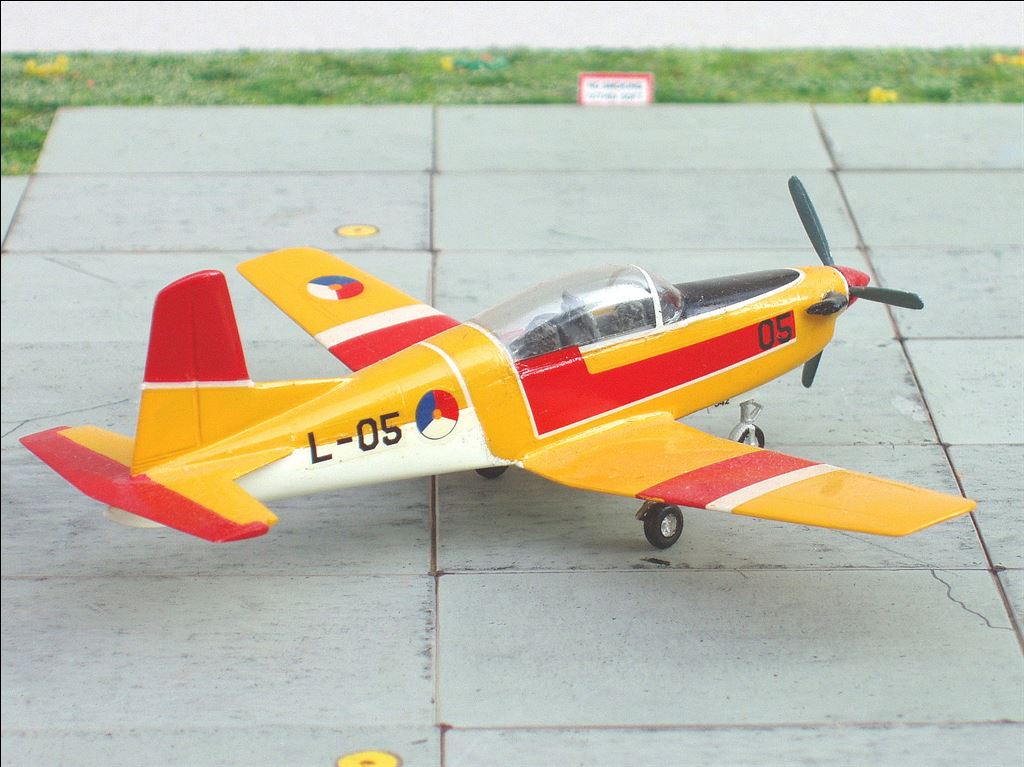
Modelling add-on
- --
- Set -: -
Decals
- --
- Set -: --
1/48th Scale
Kits
- Anáhuac Models
- Kit 1: PC-7 Pilatus (resin)
Modelling add-on
- --
- Set -: -
Decals
- --
- Set -: --
Since about 2007 the PC-7 has an new overall black colour scheme. This scheme was first applied to Pilatus L-01 in 2004.
This colour scheme is chosen because of flight safety. Research has shown that a black silhouette shows a better visibility against the sky than the earlier colour scheme of yellow and red.
| Scheme | Colour name | FS-number | BS-number | RAL | Humbrol | XtraColor | Vallejo Model Color | Vallejo Model Air | |
|---|---|---|---|---|---|---|---|---|---|
| Standard #1: Delivery scheme | Overall | Yellow | 1023 | 69 | X108 | 71.002 | |||
| parts | Red | 3020 | 174 | X014 | 70.909 | ||||
| parts | White | 9010 | 130 | ||||||
| New scheme from about 2004 | |||||||||
| Standard #2 | Overall | Black | 9005 | 33 | 70.950 | ||||
| parts | Yellow | 1023 | 69 | X108 | 71.002 | ||||
Check www.paint4models.com for an extensive conversion table with lots of colour and paint systems.
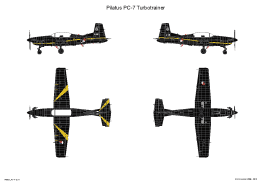

Literature.
| Luchtvaartwereld; 5e jaargang nummer 9: De Pilatus PC-7 Turbotrainer. | Hans Heerkens | Pag. 112 - 115 | 1988 | Uitgeverij Ten Brink, Meppel |
| Luchtvaartwereld; 6e jaargang nummer 3: Pilatus PC-7 | Pag. 69 - | 1989 | Uitgeverij Ten Brink, Meppel | |
| Squadrons van de Koninklijke Luchtmacht (derde herzien druk) | Willem Helfferich | Pag. 55 - 56 | 1994 | Uitgevers Wyt, Rotterdam |
| Camouflage en Kentekens | J.Greuter e.a. | 1997 | Bonneville – Bergen (NH) |
Websites.
--
- Details
- Hits: 10604
History
Pfalz Flugzeugwerke had only experience in license building of e.g. 20 Roland D.I and 200 Roland D.II fighters, when it started to develop the Pfalz D.III
November 1916 Rudolph Gehringer a designer of Flugzeugbau Friedrichshafen GmbH was hired. He designed Pfalz D.III, which was released in April 1917. The aircraft had a plywood monocoque fuselage, expensive and labour intensive to produce, but a smooth and strong construction.
IDFLieg ordered to end the production of the Roland D.II and to built the rest of the order of 70 aircraft as Pfalz D.III. After extensive tests several modifications were added, such as enlarged rudder and balanced ailerons.
A second order for 300 aircraft was received in June 1917.
The aircraft proofed to be better than the Roland D.III, but less than the Albatros D.III and D.V. Complaints were the weak engine, heavy controls, low speed and low rate of climb. Further the armament was covered in the fuselage, so the pilot was hardly able to fix problems with the guns. Advantage was the strength of the aircraft.
The Pfalz D.IIIa introduced some improvements. The armament was placed more upwards, the horizontal stabilizer was enlarged, the wings of the lower wing were clipped and it was equipped with a more powerful Mercedes D.III. Pfalz built 260 examples of the D.III and 750 examples of the Pfalz D.IIIa.
| Dimensions: | |||
| Length: | 7,1 m | Wingspan: | 9,4 m |
| Height: | 2,67 m | Wing area: | 22,17 m2 |
| Weights: | |||
| Empty weight: | 725 kg | Max. start weight: | 905 kg |
| Performances: | |||
| Max. speed: | 185 km/hr | Climbing speed: | 3,25 min to 1000 m |
| Cruising speed: | - km/hr | ||
| Range: | 2,5 hour | Service ceiling: | 5180 m |
| Miscellaneous: | |||
| Engine type: | One Mercedes D-IIIa rated 180 hp | ||
| Crew: | One aviator | ||
| Armament: | Two fixed, forward firing 7,9 mm Spandau LMG 08/15 machine guns | ||
An example of this type serialled 1306/18, airman Gefr. Heinz Kleineberg. landed on June 12, 1918 near Schoondijke. It was interned as PF225.

[Enclosed photo from BeeldBank NIMH. Click on photo for ordering information]
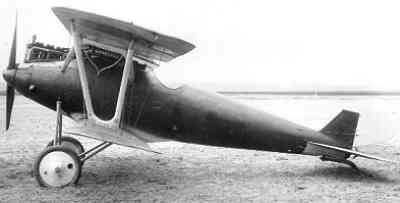
[Enclosed photo from BeeldBank NIMH. Click on photo for ordering information]
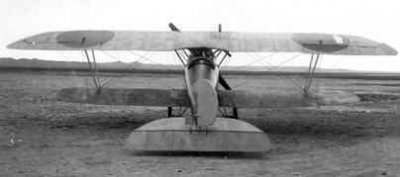
[Enclosed photo from BeeldBank NIMH. Click on photo for ordering information]
| Serial | Werknr. | Bestellnr. | Date in service | Date out of service | Notes |
|---|---|---|---|---|---|
| PF225 | 1306/18 | 12-06-1918 |
1/72nd Scale
Kits
- Encore
- Kit 72001: Re-release of the Roden Pfalz DIIIa with different decals.
- Kit 72004: Blue max, Re-release of the Roden Pfalz DIIIa with different decals
- MAC Automodelle
- Kit 72032: Pfalz DIIIa
- Roden
- Kit 015: Pfalz DIIIa
Modelling add-on
- Eduard
- Set E48-324: Detailset Pfalz DIIIa (Eduard)
- Part Etchings
- Set S72-156: Pfalz DIIIa
Decals
- --
- Set -: --
1/48th Scale
Kits
- Eduard
- Kit 4816: Pfalz D.IIIa
Modelling add-on
- Eduard
- Set E48-324: Detailset Pfalz DIIIa (Eduard)
- Part Etchings
- Set S72-156: Pfalz DIIIa
- Master, reality in Miniature
- Set AM-48-036: German WW I machine gun Parabellum LGM14 (1x)
- Set AM-48-035: German WW I machine gun Spandau LMG 08/15 (2pcs)
- LF Models
- Set FP4801: Hand made wooden prop Axial
- Set P4803: Hand made wooden prop Wien Jaray
- Set P4802: Hand made wooden prop Wotan
- Vector resin
- Set 48018: Mercedes Benz DIII/DIIIa
Decals
- --
- Kit --: ---.
At Forum World War I (Dutch) it is said this Pfalz was overall brown with a white rudder.
At Beeldbank NIMH an rear view can be found of this aircraft. The wings don't seem to have lozenge pattern applied, though some pattern is is visible on the wings.
| Scheme | Colour name | FS-number | BS-number | Humbrol | XtraColor | Vallejo Model Color | Vallejo Model Air | |
|---|---|---|---|---|---|---|---|---|
| Standard #1 | Wings | Lozenge? | ||||||
| Upper surfaces | Bronwn? | 160 | X619 | 70.984 | ||||
| Undersides | Light grey | |||||||
Check www.paint4models.com for an extensive conversion table with lots of colour and paint systems.
Literature.
| Nederlandse Militaire Luchtvaart in Beeld. deel 1. | Hugo Hooftman | Pag. 22 | 1977 | Uitgever: Europese Bibliotheek, Zaltbommel |
| KLu Vliegtuigen: De vliegtuigen van de Koninklijke Luchtmacht vanaf 1913 | Wim Schoenmaker & Thijs Postma | Pag. 17 | 1987 | Uitgeverij De Alk, Alkmaar |
| Van Luchtvaartafdeling tot Koninklijke Luchtmacht 75 jaar Militaire Luchtvaart in Nederland | Koos van de Berg | Pag. 10 | 1987 | Uitgever: Rebo Produkties, Sassenheim |
| Aircraft Archive Aircraft of World War One; Volume 1. | Pag. 82 - 83 | 1989 | Uitgever: Argus Books, Hempsted | |
| Camouflage en Kentekens | J.Greuter e.a. | 1997 | Bonneville – Bergen (NH) | |
| Air Enthusiast no.80 The Historical Aviation Journal: Unexpected Windfalls | Bart van der Klaauw | Pag. 54 - 59 | 1999 | Uitgever: Key Publishing, Stamford |
Websites.
--
- Details
- Hits: 9128
History
When the aircraft factory NVI went bankrupt in 1924, the staff and property were taken over by furniture factory Pander and housed in Dutch Aircraft Factory H. Pander & Zonen.
The Holland H2 design, derived from the Carley C.12 was further developed and released as Pander D. This was a small single shoulder wing monoplane with a three-cylinder Anzani engine of 30 hp.
The Pander D was sleeker, had a rounder hull and revised wings.
The wooden wing was one piece with two main girders. The monocoque hull consisted of triplex.
The Pander D made its First flight on November 16, 1924, and was shown for the first time in public at the 1925 air show at Paris.
In the end ten examples were built. Six of them for the civil market and two examples for the Dutch Navy and two examples for the NEIAF.
| Dimensions: | |||
| Length: | 4,95 m | Wingspan: | 8 m |
| Height: | 1,65 m | Wing area: | 10,80 m2 |
| Weights: | |||
| Empty weight: | 190 kg | Max. start weight: | 305 kg |
| Performances: | |||
| Max. speed: | 130 km/hr | Climbing speed: | - m/min |
| Cruising speed: | 90 km/hr | ||
| Range: | - km | Service ceiling: | - m |
| Miscellaneous: | |||
| Engine type: | One Anzani 25 rated 25 hp | ||
| Crew: | One aviator | ||
| Armament: | None | ||
In service with RNlNAS and NEIAF.
Both de Dutch Navy as het NEIAF ordered two exampes of the Pander D. These were intended as an inexpensive way to maintain the flying skills. They were mostly used to make pleasure flights.
| Serial | Constr. nr. | Date in service | Date out of service | Notes |
|---|---|---|---|---|
| In service with RNlNAS. | ||||
| P-1 | 14 | 15-07-1925 | 1-1-1927 | 1927 withdrawn from use |
| P-2 | 15 | 15-07-1925 | 17-01-1927 | Used from RNAS De Mok Crashed near De Kooy |
| In service with NEIAF | ||||
| P.501 | 16 | 02-11-1925 | 04-1931 | Initial serial also P.1; Scrapped. |
| P.502 | 19 | 02-11-1925 | 03-1929 | Initial serial also P.2. Crashed Kalidjati. |
1/72nd Scale
Kits
- --
- Kit --: ---
Modelling add-on
- --
- Set --: --
Decals
- --
- Set --: --
1/48th Scale
Kits
- --
- Kit --: --
Modelling add-on
- --
- Set --: --
Decals
- --
- Set --: --
| Scheme | Colour name | FS number | WEM | Humbrol | XtraColor | Vallejo Model Color | Vallejo Model Air | |
|---|---|---|---|---|---|---|---|---|
| Pander D RNlNAS and NEIAF | ||||||||
| Standard #1 | Overall | Khaki | AC D04 | 29? / 155? | x2? /x251? | 70.921? / 70.887 | ||
Check www.paint4models.com for an extensive conversion table with lots of colour and paint systems.
Literature.
| AVIA: 32e jaargang nummer 6: Lezers schrijven: De Panders in Nederlands-Indië | F. Zandvliet | Pag. 222 | 1973 | Uitgevers Wyt, Rotterdam |
| Nederlandse Marinevliegtuigen | Thijs Postma & Nico Geldhof | Pag. 16; 19 | 1978 | Uitgever: Omniboek, 's Gravenhage |
| Militaire Luchtvaart in Nederlandsch-Indië in beeld. Deel 1 | Hugo Hooftman | Pag. 67 | 1978 | Uitgever: Europese Bibliotheek, Zaltbommel |
| Zestig jaar Marineluchtvaartdienst in Beeld. | Hugo Hooftman | Pag. 22 - | 1977 | Uitgever: Europese Bibliotheek, Zaltbommel |
| Pander Type D Een Aviodome publicatie | W.C.J. van Westerop | Pag. | 1979 | Uitgever: Aviodome, Amsterdam |
| De Nederlandse Vliegtuigen: Alle vliegtuigen ooit in Nederland ontworpen en gebouwd | Theo Wesselink & Thijs Postma | Pag. 57 | 1982 | Uitgever: Romen Luchtvaart, Haarlem |
| Camouflage en Kentekens | J.Greuter e.a. | 1997 | Bonneville – Bergen (NH) | |
| 85 JAAR Marineluchtvaartdienst in beeld Van Farman tot NH 90 Helikopter | Peter Korbee | Pag. 42 - 43 | 2002 | Uitgever: Korbee MLD Promotie, Valkenburg |
Websites.
--
